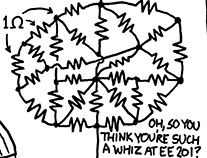Not sure if this is what you're asking, but yes, when the battery is connected, an electric field wave travels from the battery down the wires to the load. Part of the electrical energy is absorbed by the load (depending on Ohm's law), and the rest is reflected off the load and travels back to the battery, some is absorbed by the battery (Ohm's law again) and some reflects off the battery, etc. Eventually the combination of all the bounces reaches the stable steady-state value that you would expect.
We usually don't think of it this way, because in most circuits it happens too quickly to measure. For long transmission lines it is measurable and important, however. No, the current does not "know" what the load is until the wave reaches it. Until that time, it only knows the characteristic impedance or "surge impedance" of the wires themselves. It doesn't yet know if the other end is a short circuit or an open circuit or some impedance in between. Only when the reflected wave returns can it "know" what's at the other end.
See Circuit Reflection Example and Transmission line effects in high-speed logic systems for examples of lattice diagrams and a graph of how the voltage changes in steps over time.
And in case you don't understand it, in your first circuit, the current is equal at every point in the circuit. A circuit is like a loop of pipework, all filled with water. If you cause the water to flow with a pump at one point, the water at every other point in the loop has to flow at the same rate.
The electric field waves I'm talking about are analogous to pressure/sound waves traveling through the water in the pipe. When you move water at one point in the pipe, the water on the other end of the pipes doesn't change instantly; the disturbance has to propagate through the water at the speed of sound until it reaches the other end.
Your question is far from clear to me. Your first schematic doesn't even show an LED. I will try to explain how everything works without any mysticism.
Resistors have two terminals, and they enforce a rule between those two terminals.
The rule is called "Ohm's law." Mathematically, the rule is V = I * R.
V is the voltage across the resistor.
I is the current flowing through the resistor.
R is the characteristic value of the resistor, normally measured in units called "Ohm's." Your resistors are 1k, so V = I * 1000.
Diodes are more complicated, so I am going to give you a simplified model. Assuming voltage polarity on the diode is correct (forward bias) the rule enforced by the diode is approximately V = K. (K is a constant). However, if the circuit is not capable of supplying that voltage across the diode, then it will enforce a different rule: I = 0. The constant, K, depends on the type of diode.
For an LED, any time I > 0, it may be emitting light. Red LED's are especially sensitive, and will emit light when even a tiny current is flowing.
A voltage supply also enforces the rule V = constant, normally by supplying current from its + terminal.
You put all these rules together, and hopefully everything will make sense. What circuits do is find the one unique solution to all the various rules. Sometimes the solution conditions cause the diode current (and light) to be zero. One way to check is to remove the diode from the circuit, then solve it. If V where the diode is supposed to go is > K for that diode, then the diode is in forward bias, and you need to put it back in and solve for the circuit assuming the voltage at that node is K.
Hope this makes some sense.

Best Answer
Well in the particular diagram you have shown there appears only one wire coming in. So there will be no current flow in any of the resistors and all the nodes will be at the same voltage.
Edit: looking at the full nonsense circuit on XKCD there is a wire coming into the top of the subcircuit you pictured which you cropped off. If you connected a voltage source to the top and bottom of the circuit you could solve it by the means below.
But in general you can solve a circuit with lots of resistors by the following procedure.